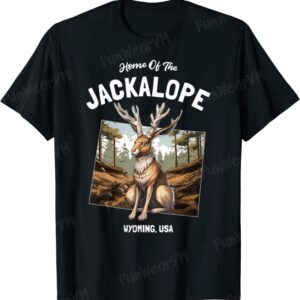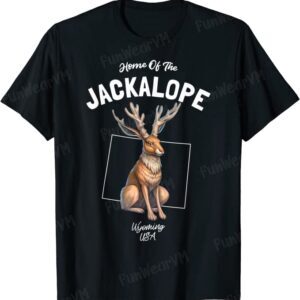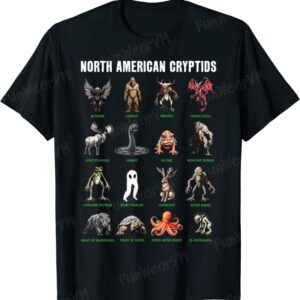
The jackalope is a legendary animal that looks like a rabbit with antlers, and it is said to inhabit the American West. Some people claim to have seen it, others have mounted its head on their walls, and still others have made it into a symbol of their businesses or products. But what is the truth behind this mysterious creature? Is it real or just a hoax? And what does it have to do with cancer research?
Unveiling the Legend of the Jackalope: North America’s Horned Hare
Imagine traversing the rugged landscapes of the American West, the sun setting on the horizon, painting the sky in hues of orange and purple. Suddenly, a flicker of movement catches your eye. A creature unlike any you’ve seen before bounds across the plains – a jackrabbit, fleet-footed and familiar, yet crowned with a majestic set of antlers. This captivating image is the essence of the jackalope, a mythical animal deeply embedded in the folklore of North America, particularly the wild and wonderful American West.1 More than just a figment of imagination, the jackalope has hopped its way into the hearts and stories of many, becoming a true cultural icon.
At its heart, the jackalope is a fascinating hybrid, a whimsical blend of two creatures familiar to the Western landscape: the jackrabbit and the antelope.1 While the name itself is a straightforward combination of these two, the reality, like many good legends, is a bit more nuanced. Often depicted with the branching horns of a deer in taxidermied displays, the jackalope occupies a special place within the pantheon of “fearsome critters,” those fantastical beasts that roam the landscape of North American tall tales, often possessing exaggerated and humorous characteristics.2 The very notion of a rabbit adorned with antlers is inherently striking, a delightful absurdity that sparks curiosity and invites the creation of countless stories. This unexpected combination of two distinct animals is likely a key reason for the jackalope’s enduring appeal, prompting both amusement and a sense of wonder at the possibilities of nature.
This exploration will delve into the captivating world of the jackalope. We will uncover the details of its described physical appearance, trace the history of reported sightings across the continent, examine its significant cultural impact on different regions, and investigate the potential scientific explanations that might lie beneath the surface of this enduring myth.
The Jackalope’s Distinctive Features: Horned Hare or Antelabbit?
The most fundamental aspect of the jackalope is its unique appearance, a striking combination of lagomorph and ungulate features. The creature is primarily described as having the body of a jackrabbit.2 It is worth noting that jackrabbits, with their long ears and powerful hind legs designed for swift escapes across open terrain, are actually hares, belonging to the genus Lepus, rather than true rabbits. This zoological distinction adds an interesting layer to the tale.
The defining characteristic, of course, is the presence of antlers, typically described as being antelope-like, often with two prongs, reminiscent of the pronghorn (Antilocapra americana).1 However, it is a common sight to see taxidermied jackalopes sporting the more readily available antlers of a deer.1 Less frequently, descriptions might include other fantastical additions, such as a pheasant’s tail or legs, further blurring the lines of reality and enhancing its mythical charm.7
The name “jackalope” itself is a straightforward portmanteau, neatly blending “jackrabbit” and “antelope”.1 It’s a simple, descriptive term that has become widely recognized. Regarding the “antelope” part of the name, it specifically refers to the pronghorn, a unique North American mammal found only in western regions. Despite its common name, the pronghorn is not a true antelope from the Old World but belongs to its own family, Antilocapridae, and is actually more closely related to giraffes.2 Adult pronghorns can grow to be about three feet tall, weigh up to 150 pounds, and are known for their incredible speed, capable of sustained speeds approaching 60 miles per hour.2
The size of the jackalope in folklore varies considerably. While some accounts depict it as being roughly the size of a typical jackrabbit, weighing between one and ten pounds 4, other tales describe it as growing much larger, reaching the size of a medium-sized dog, around 60 pounds.14 Some of the more fantastical stories even speak of a long-extinct “Sabretooth Jack,” a formidable creature said to have weighed up to 150 pounds.14 The most common fur color associated with the jackalope is brown, similar to that of a wild rabbit.12 However, variations exist, with some descriptions noting tawny, fawn, or grayish hues, and occasionally, distinct white patches on the throat, belly, and rump.13 This inconsistency in the jackalope’s described features, particularly the type of antlers and its size, suggests that the central idea of a horned rabbit is more important in the folklore than strict anatomical accuracy. This flexibility allows for a richer and more imaginative narrative, adapting to different storytellers and regional interpretations.
The diverse physical descriptions of the jackalope can be summarized as follows:
| Feature | Common Description | Variations & Snippet IDs |
| Body | Jackrabbit (hare) | Sometimes with pheasant tail/legs 7 |
| Horns | Antelope-like (pronghorn) | Often depicted as deer antlers 1, single horn 2, multiple horns 20 |
| Size | 1-10 pounds | Up to 60 pounds 14, even larger (150 lbs – Sabretooth Jack) 14 |
| Fur Color | Brown | Tawny, fawn, gray, white patches 13 |
Have You Seen One? A Look at Jackalope Sightings in North America
The jackalope is most strongly associated with the American West, becoming practically synonymous with the region’s rugged landscapes and independent spirit.2 Within this vast area, the town of Douglas, Wyoming, proudly proclaims itself the “Jackalope Capital of the World”.2 This title is not taken lightly; the town even features an eight-foot statue of the mythical creature in its town square and hosts an annual Jackalope Days celebration, further cementing its connection to the legend.19
While Wyoming holds the most prominent place in jackalope lore, reported sightings and cultural associations extend to other Western states as well. Colorado, Nebraska, South Dakota, Arizona, Texas, and even Washington have all been mentioned as locations where the elusive creature has been spotted or where its legend holds sway.4 Some accounts even suggest that cowboys frequently encountered jackalopes on the Western prairie in the 1800s, though reports have become less common in modern times.4 These historical references contribute to the sense of a long-standing myth deeply rooted in the region’s past.
Anecdotes of personal jackalope “sightings” abound, often shared with a wink and a nod. These stories, whether told in earnest or jest, help to keep the legend alive in local communities.18 Adding to the playful nature of the jackalope phenomenon, the town of Douglas has a humorous tradition of selling jackalope hunting licenses. These licenses often come with absurd conditions, such as restricting the hunting season to June 31st and requiring the hunter to have an IQ between 50 and 72.23 The reported sightings, even if largely anecdotal, play a crucial role in maintaining the jackalope’s mystique. The very idea that someone might have glimpsed this unusual creature reinforces its place in the cultural narrative, blurring the line between reality and imagination. Furthermore, the concentration of jackalope lore in specific regions and the development of local traditions around it, such as Jackalope Days, demonstrate how folklore can become deeply intertwined with regional identity, fostering a sense of shared cultural heritage.
More Than Just a Myth: The Jackalope in Folklore and Culture
The jackalope has evolved into a powerful symbol of the American West, embodying its unique blend of ruggedness, humor, and imaginative storytelling.2 Its image is ubiquitous across the region, prominently featured in roadside attractions, where taxidermied versions often greet travelers, and in countless souvenirs, from postcards and keychains to the ever-popular “jackalope milk”.2 Local businesses often incorporate the jackalope into their branding, further solidifying its presence in everyday life.
Beyond its regional significance, the jackalope has hopped into mainstream popular culture. It has made appearances in movies, such as the Pixar short film Boundin’ 16, television shows like America’s Funniest People 16, and even video games like Red Dead Redemption.53 Artists have also embraced the jackalope, depicting it in various styles and mediums.2
Adding to its folkloric charm are the numerous humorous and often outlandish claims about jackalope behavior and habits. Legend has it that they are incredibly fast, capable of reaching speeds of up to 90 or even 120 miles per hour.17 They are also said to possess the remarkable ability to mimic human voices, even singing along with cowboys around a campfire, often in a tenor voice.2 Some tales claim that jackalopes only mate during lightning storms, accounting for their supposed rarity.2 It is also said that they have a fondness for whiskey, which can be used to lure them.2 Despite their seemingly whimsical nature, jackalopes are sometimes portrayed as being dangerous and aggressive when cornered.2
Regional variations in jackalope folklore also exist. For example, it is sometimes referred to as the “warrior rabbit” 2, the “antelabbit” 9, or the “phesalope” or “flying jackalope” in South Dakota, said to have a bird-like body.9 A Canadian version, known as the “Elkhare,” is said to inhabit northern British Columbia.21 These localized adaptations demonstrate the myth’s flexibility and how it can be tailored to specific regions.
Interestingly, the jackalope is not alone in the world of horned rabbit legends. Similar creatures appear in the folklore of other cultures, such as the German wolpertinger, a bizarre hybrid often depicted with a rabbit’s head, squirrel’s body, deer antlers, and pheasant’s wings 2, and the Persian al-mi’raj, described as a yellow hare with a single black horn.2 Even medieval texts and illustrations from Europe depict horned hares, suggesting a long history of this image in human imagination.2 The jackalope’s journey from a regional Wyoming joke to a widely recognized cultural icon highlights the power of storytelling and the human capacity for embracing the fantastical. Its widespread presence in various aspects of American life underscores its legendary status. The similarities with horned rabbit myths from other cultures hint at a possible shared fascination or perhaps even a common origin in real-world observations.
The Science Behind the Spectacle: Potential Explanations for Jackalope Sightings
While the jackalope reigns supreme in the realm of folklore, science offers some intriguing potential explanations for its origins. The most prominent of these is the Shope papilloma virus (SPV).2 This virus, belonging to the papovavirus group, infects various leporids, including cottontail rabbits, jackrabbits, and even domestic rabbits, causing the growth of hard, keratinous tumors. These growths often appear on the head, face, and ears of the infected animals and can, in some cases, resemble horns or antlers.2 It is important to note that these are not true bone antlers but rather skin growths made of keratin, the same protein found in human hair and nails.39
The Shope papilloma virus was first scientifically described by Dr. Richard Shope in the 1930s 2, around the same time that the jackalope myth gained significant popularity, largely due to the antics of two brothers in Wyoming. This temporal coincidence suggests a possible link between sightings of rabbits afflicted with this virus and the enduring tales of horned hares. Furthermore, research into the Shope papilloma virus surprisingly played a crucial role in the development of the Human Papillomavirus (HPV) vaccine, a major medical advancement in the prevention of certain cancers.42
Another significant factor in the popularization of the jackalope is the well-documented taxidermy hoax initiated by Douglas and Ralph Herrick in Douglas, Wyoming, starting in the 1930s.2 The story goes that after a hunting trip, they playfully attached deer antlers to a jackrabbit carcass. This whimsical creation was then displayed in a local hotel and quickly captured the public’s imagination, leading to numerous sales and the widespread dissemination of the jackalope image.2 While the jackalope as a true hybrid remains a delightful hoax, the Herrick brothers’ contribution was instrumental in shaping its modern image.
Other potential explanations for jackalope sightings include the misidentification of young deer or pronghorns, particularly fawns with small antlers, or even the psychological phenomenon of pareidolia, where the human brain interprets vague or random stimuli as familiar patterns.24 The simultaneous emergence of the jackalope myth and the discovery of the Shope papilloma virus is a remarkable coincidence, suggesting a possible real-world basis for the folklore that was then amplified and solidified by the Herrick brothers’ famous hoax. Furthermore, the unexpected link between the study of this virus and the development of the HPV vaccine adds a fascinating layer of scientific significance to this seemingly whimsical creature of myth.
Capturing the Cryptid: Jackalopes in Images and Videos
The jackalope’s image is widely disseminated through a variety of media, reflecting its prominent place in popular culture. Perhaps the most iconic visual representation is the taxidermy mount, often found adorning the walls of bars, restaurants, and souvenir shops throughout the American West.1 These often serve as humorous reminders of local folklore and make for memorable photo opportunities.
Beyond taxidermy, a vast array of illustrations, cartoons, and artwork depict the jackalope in countless styles.2 From vintage-inspired drawings to whimsical cartoons and contemporary digital art, these depictions further solidify the jackalope’s place in popular culture.
Jackalope-themed festivals and events, such as the annual Jackalope Days in Douglas, Wyoming, often generate associated photos and videos, capturing the community’s enthusiastic embrace of their mythical mascot.2 Furthermore, numerous documentaries, news reports, and online videos explore the jackalope legend, delving into its history, cultural significance, and potential scientific explanations.2 Examples include “The Jackalope Chronicles” 109, various videos on platforms like YouTube exploring its origins and folklore 23, and even podcast episodes dedicated to Wyoming’s most disturbing cryptid.118 These readily available images and videos online demonstrate the jackalope’s continued relevance and its effectiveness as a recognizable cultural symbol.
Digging Deeper: Reputable Sources for Jackalope Lore
For those interested in exploring the legend of the jackalope further, several reputable sources offer valuable information:
- Cryptozoology Websites: Websites like Cryptomundo 22 and CryptoZooNews 127 often feature articles and discussions about cryptids, including the jackalope.
- Folklore Archives: Exploring university or regional folklore archives, such as the Wyoming Folklife Archive 31, can provide insights into the traditional stories and beliefs surrounding the jackalope.
- Books on Cryptozoology and American Folklore: Michael P. Branch’s book, On the Trail of the Jackalope: How a Legend Captured the World’s Imagination and Helped Us Cure Cancer 4, and Andy Robbins’ Field Guide to the North American Jackakope 4 are excellent resources dedicated to the topic.
- Museums with Cryptozoology Exhibits: The International Cryptozoology Museum in Portland, Maine 47, features exhibits on various cryptids, including representations of the jackalope.
- Academic Databases: For information on the Shope papilloma virus, academic databases like PubMed and Google Scholar can be searched using relevant keywords.66
It is important for readers to critically evaluate their sources and to distinguish between anecdotal accounts, traditional folklore, and peer-reviewed scientific research.
Conclusion: The Enduring Appeal of the Mythical Jackalope
The legend of the jackalope, a captivating blend of jackrabbit and antelope (or deer), stands as a testament to the power of folklore and the enduring appeal of the unusual. From its likely origins in sightings of rabbits afflicted with the Shope papilloma virus to its popularization as a whimsical taxidermy hoax in the American West, the jackalope has hopped its way into the cultural consciousness, becoming a beloved symbol of the region’s spirit of adventure and tall tales.2
Its distinctive appearance and the often humorous stories surrounding its habits have made it a favorite subject for roadside attractions, souvenirs, and popular culture. The jackalope’s ability to spark imagination and evoke a sense of wonder, even in those who know it to be a myth, is a key reason for its lasting appeal. It embodies the joy of storytelling and the human fascination with the unknown, reminding us that sometimes, the most captivating creatures are those that exist only in our collective imagination. The jackalope, in its unique way, continues to enrich the cultural landscape of North America, a horned hare forever bounding through the realms of myth and legend.
Sources
en.wikipedia.org, accessed April 11, 2025, https://en.wikipedia.org/wiki/Jackalope#:~:text=The%20jackalope%20is%20a%20mythical,are%20made%20with%20deer%20antlers.
Jackalope – Wikipedia, accessed April 11, 2025, https://en.wikipedia.org/wiki/Jackalope
The world’s scariest rabbit lurks within the Smithsonian’s collection, accessed April 11, 2025, https://www.si.edu/stories/worlds-scariest-rabbit
North American Jackalope | Prairie Public, accessed April 11, 2025, https://news.prairiepublic.org/podcast/natural-north-dakota/2023-04-01/north-american-jackalope
The Story Behind Jackalope, accessed April 11, 2025, https://www.jackalopeartfair.com/blog/thejackalope
The Jackalope: Unraveling the Mystery of America’s Legendary Cryptid | Lori Lee Sampson, accessed April 11, 2025, https://www.starglowstudio.com/blog/196058/the-jackalope-unraveling-the-mystery-of-americas-legendary-cryptid
Jackalope Print – Mythic Articulations, accessed April 11, 2025, http://www.mythicarticulations.com/jackalope-print.html
Fearsome Critters | Fabulous Realms, accessed April 11, 2025, https://ashsilverlock.wordpress.com/2016/06/19/fearsome-critters/
Jackalope – Wikipedia, the free encyclopedia, accessed April 11, 2025, http://taggedwiki.zubiaga.org/new_content/1be88d172cc99c1bfba46b0285807f5d
Tell us about an interesting creature from the folklore of your area that is unknown to the rest of the world. : r/mythology – Reddit, accessed April 11, 2025, https://www.reddit.com/r/mythology/comments/odwrio/tell_us_about_an_interesting_creature_from_the/
The jackalope is a mythical animal of North American folklore (a so-called “fearsome critter”) described as a jackrabbit with antelope horns or deer antlers and sometimes a pheasant’s tail (and often hind legs). – Reddit, accessed April 11, 2025, https://www.reddit.com/r/Awwducational/comments/1q6gm4/the_jackalope_is_a_mythical_animal_of_north/
The Jackalope – ArcGIS StoryMaps, accessed April 11, 2025, https://storymaps.arcgis.com/stories/f16385a3b1784203900c0efdd1a1b3ff
Jackalope Species in Ferlausen | World Anvil, accessed April 11, 2025, https://www.worldanvil.com/w/ferlausen-dedicatedfollower467/a/jackalope-species
The legend of the horned rabbit of the West – High Country News, accessed April 11, 2025, https://www.hcn.org/articles/books-the-legend-of-the-horned-rabbit-of-the-west/
The Jackalope and the Evolving American Folklore – American …, accessed April 11, 2025, https://americanrobotnik.com/2011/12/jackalope-myth/
Jackalope – WikiFur, the furry encyclopedia, accessed April 11, 2025, https://en.wikifur.com/wiki/Jackalope
The Legend of the Horned Rabbit of the West – Bunk History, accessed April 11, 2025, https://www.bunkhistory.org/resources/the-legend-of-the-horned-rabbit-of-the-west
Creature Feature: Jackalope – The Ethogram, accessed April 11, 2025, https://theethogram.com/2024/04/01/creature-feature-jackalope/
What is a Jackalope? Creature Amazes Visitors of Douglas, Wyoming, accessed April 11, 2025, https://travelwyoming.com/blog/stories/post/jackalope-amaze-visitors-of-douglas-wyoming/
A Jackalope Sighting in Utah? Horned Rabbits are the Mascots of the American West, but are they Real?, accessed April 11, 2025, https://utahstories.com/2022/06/a-jackalope-sighting-in-utah-horned-rabbits-are-the-mascots-of-the-american-west-but-are-they-real/
Jackalope [Fearsome Critter|Cryptid] – Sam kalensky, accessed April 11, 2025, https://samkalensky.com/en-us/products/jackalope
Move Over Jackalope: Meet South Dakota’s Version of Bigfoot – ESPN Sioux Falls, accessed April 11, 2025, https://espnsiouxfalls.com/ixp/486/p/south-dakota-version-bigfoot/
The United States of Cryptids: The Jackalope – YouTube, accessed April 11, 2025, https://www.youtube.com/watch?v=Aggi3fEfDKs
Rare Jackalope Sighting at Riverside State Park – Washington State Parks Foundation, accessed April 11, 2025, https://waparks.org/rare-jackalope-sighting-at-riverside-state-park/
The Legend of the Jackalope – Live WYld Magazine, accessed April 11, 2025, https://www.livewyldmag.com/live-wyld/the-legend-of-the-jackalope
The Truth Behind the Jackalope and Those Who Hunt the Elusive Warrior Rabbit, accessed April 11, 2025, https://www.ancient-origins.net/myths-legends-americas/jackalope-0011623
Jackalope Habitat Suitability for Conservation in Wyoming – ArcGIS StoryMaps, accessed April 11, 2025, https://storymaps.arcgis.com/stories/84953e3ea6fd4caba27998ea80062a38
The Dubois Jackalope: A Unique Genetic Variant?, accessed April 11, 2025, https://livingdubois.com/2018/01/04/the-dubois-jackalope-a-unique-genetic-variant/
Did You Know: Wyoming’s Mythical Creature, accessed April 11, 2025, https://www.westernwyoming.edu/blogs/outdoors/wyomings-mythical-creature.php
Of Western myth and jackalopes – High Country News, accessed April 11, 2025, https://www.hcn.org/issues/issue-246/of-western-myth-and-jackalopes/
Tall Tales and Other Oddities – The Fabulous Jackalope of Wyoming, accessed April 11, 2025, https://ahcwyo.org/2025/03/03/tall-tales-and-other-oddities-the-fabulous-jackalope-of-wyoming/
Preserving Culture, or a Brief History of the Jackalope – Dilettante Army, accessed April 11, 2025, https://dilettantearmy.com/articles/jackalope
Does the Jackalope Really Roam the State of Wyoming? – Science | HowStuffWorks, accessed April 11, 2025, https://science.howstuffworks.com/science-vs-myth/strange-creatures/jackalope.htm
Quest For The Jackalope, accessed April 11, 2025, https://www.backpacker.com/stories/quest-for-the-jackalope/
Jackolope experts, surprisingly, don’t get rich | Kitsap Daily News, accessed April 11, 2025, https://www.kitsapdailynews.com/opinion/jackolope-experts-surprisingly-dont-get-rich/
Jackalopes The elusive Jackalopes, history, lore, it’s… – Veterans Oasis Park, accessed April 11, 2025, https://veteransoasispark.com/wild-animals-in-az/jackalopes/
Story behind the mythical Great Nevada Jackalope – The Record Courier, accessed April 11, 2025, https://www.recordcourier.com/news/2007/sep/13/story-behind-the-mythical-great-nevada-jackalope/
Jackalope Hunting License – Douglas, WY, accessed April 11, 2025, https://www.cityofdouglas.org/DocumentCenter/View/104/Jackalope-hunting-license?bidId=
Plesiosaur sightings : r/Cryptozoology – Reddit, accessed April 11, 2025, https://www.reddit.com/r/Cryptozoology/comments/ivxo04/plesiosaur_sightings/
Move over Elvis: History hopping with jackalope sightings – SFGATE, accessed April 11, 2025, https://www.sfgate.com/travel/article/Move-over-Elvis-History-hopping-with-jackalope-3207270.php
Abominable Science!: Origins of the Yeti, Nessie, and Other Famous …, accessed April 11, 2025, https://dokumen.pub/abominable-science-origins-of-the-yeti-nessie-and-other-famous-cryptids-9780231526814-l-7067262.html
How the mythical jackalope inspired a real cancer breakthrough – KJZZ, accessed April 11, 2025, https://www.kjzz.org/2022-04-07/content-1770393-jackalope-myth-it-inspired-real-cancer-breakthrough
On the Trail of the Jackalope | The Scientist, accessed April 11, 2025, https://www.the-scientist.com/on-the-trail-of-the-jackalope-69653
Texas Tales: Lone Star State bears no blame for jackalope myth – Bluebonnet News, accessed April 11, 2025, https://bluebonnetnews.com/2021/08/30/texas-tales-lone-star-state-bears-no-blame-for-jackalope-myth/
Jackalope Photos and Images – Shutterstock, accessed April 11, 2025, https://www.shutterstock.com/search/jackalope
Jackalope hi-res stock photography and images – Alamy, accessed April 11, 2025, https://www.alamy.com/stock-photo/jackalope.html
Our History | International Cryptozoology Museum, accessed April 11, 2025, https://cryptozoologymuseum.com/our-history/
Jackalopes Are Real | MeatEater Conservation News, accessed April 11, 2025, https://www.themeateater.com/conservation/wildlife-management/bar-room-banter-jackalopes-are-real
Modern-day ‘Mythical’ Creatures – World Bird Sanctuary, accessed April 11, 2025, http://world-bird-sanctuary.blogspot.com/2015/08/modern-day-mythical-creatures.html
Tale of the Jackalope – Episode Text Transcript – 99% Invisible, accessed April 11, 2025, https://99percentinvisible.org/episode/tale-of-the-jackalope/transcript/
The Legend of the Jackalope – Flat Creek Inn, accessed April 11, 2025, https://www.flatcreekinn.com/the-legend-of-the-jackalope/
Tale of the Jackalope – 99% Invisible, accessed April 11, 2025, https://99percentinvisible.org/episode/tale-of-the-jackalope/
The History of the Jackalope In 2 Minutes – YouTube, accessed April 11, 2025, https://www.youtube.com/watch?v=AVWlt4I7yS4
Releasing the Jackalope – Kenyon Alumni Magazine, accessed April 11, 2025, https://bulletin.kenyon.edu/feature/releasing-the-jackalope/
On the Trail of the Jackalope: How a Legend Captured the World’s Imagination and Helped Us Cure Cancer – Everand, accessed April 11, 2025, https://www.everand.com/book/559219665/On-the-Trail-of-the-Jackalope-How-a-Legend-Captured-the-World-s-Imagination-and-Helped-Us-Cure-Cancer?utm_medium=cpc&utm_source=slideshare&utm_campaign=pmp_recs-v1
Jackalope Spotting | Natural History Wanderings, accessed April 11, 2025, https://naturalhistorywanderings.com/2021/04/01/jackalope-spotting/
What is The Jackalope? – YouTube, accessed April 11, 2025, https://www.youtube.com/watch?v=2uG7nbF6r8o
Mythical Monster Research:Jackalope | bulb, accessed April 11, 2025, https://www.bulbapp.com/u/mythical-monster-research-jackalope
Jackalope Moon – Fox Spirit Design, accessed April 11, 2025, https://foxspiritdesign.com/pages/jackalope-moon
Elfendritschenwolpertinger – Sophienburg Museum and Archives, accessed April 11, 2025, https://sophienburg.com/elfendritschenwolpertinger/
German folklore: The Wolpertinger – IamExpat in Germany, accessed April 11, 2025, https://www.iamexpat.de/lifestyle/lifestyle-news/german-folklore-wolpertinger
RABBITRABBITRABBIT – Rabbits and Hares in Folklore Pins – Monica L knighton, Illustration, accessed April 11, 2025, https://monicalknighton.com/rabbitrabbitrabbit-rabbits-and-hares-in-folklore-pins
My Idea for a Pokémon Region based on Germany (details in comments) : r/pokemon, accessed April 11, 2025, https://www.reddit.com/r/pokemon/comments/jfylem/my_idea_for_a_pok%C3%A9mon_region_based_on_germany/
What evolutionary advantage would a Jackalope’s horns give it? : r/cryptids – Reddit, accessed April 11, 2025, https://www.reddit.com/r/cryptids/comments/18c81t1/what_evolutionary_advantage_would_a_jackalopes/
The Elbert Files: Jackalopes – Business Record, accessed April 11, 2025, https://www.businessrecord.com/the-elbert-files-jackalopes/
Rabbit (Shope) Papilloma Virus – College of Veterinary Medicine – University of Missouri, accessed April 11, 2025, https://cvm.missouri.edu/diseases-of-research-animals-dora/rabbits/rabbit-shope-papilloma-virus/
Viral Diseases of Rabbits – Exotic and Laboratory Animals – Merck Veterinary Manual, accessed April 11, 2025, https://www.merckvetmanual.com/exotic-and-laboratory-animals/rabbits/viral-diseases-of-rabbits
Shope papilloma virus – Head Tumors and Cancer in Rabbits – PetMD, accessed April 11, 2025, https://www.petmd.com/rabbit/conditions/viral/c_rb_shope_papilloma_virus
Shope papilloma virus – Wikipedia, accessed April 11, 2025, https://en.wikipedia.org/wiki/Shope_papilloma_virus
The rabbit papillomavirus model: a valuable tool to study viral–host interactions – PMC, accessed April 11, 2025, https://pmc.ncbi.nlm.nih.gov/articles/PMC6501911/
A Century of Shope Papillomavirus in Museum Rabbit Specimens – PMC – PubMed Central, accessed April 11, 2025, https://pmc.ncbi.nlm.nih.gov/articles/PMC4493010/
Cottontail Rabbit Papillomavirus (CRPV) Related Animal Models for Head and Neck Cancer Research: A Comprehensive Review of the Literature – MDPI, accessed April 11, 2025, https://www.mdpi.com/1999-4915/16/11/1722
Rabbit with Shope papilloma virus which causes the cutaneous horns – Reddit, accessed April 11, 2025, https://www.reddit.com/r/natureismetal/comments/1096vs1/rabbit_with_shope_papilloma_virus_which_causes/
People need to read the pinned post, hoax animals like the jackalope were never cryptids : r/Cryptozoology – Reddit, accessed April 11, 2025, https://www.reddit.com/r/Cryptozoology/comments/12ynxlm/people_need_to_read_the_pinned_post_hoax_animals/
Tumors on a rabbit. It’s possible that the myth of the jackalope rose from somebody seeing these thinking they were antlers : r/natureismetal – Reddit, accessed April 11, 2025, https://www.reddit.com/r/natureismetal/comments/bid6vk/tumors_on_a_rabbit_its_possible_that_the_myth_of/
Are jackalopes real? – Zoo Atlanta, accessed April 11, 2025, https://zooatlanta.org/are-jackalopes-real/
Move Over Jackalope: Meet South Dakota’s Version of Bigfoot – KXRB, accessed April 11, 2025, https://kxrb.com/ixp/486/p/south-dakota-version-bigfoot/
Meet South Dakota’s Version of Bigfoot, accessed April 11, 2025, https://b1027.com/south-dakotas-most-famous-mythical-creature-isnt-the-jackalope/
The World’s Largest Jackalope Is Found in This Wyoming Town – Y95 Country, accessed April 11, 2025, https://y95country.com/the-worlds-largest-jackalope-is-found-in-this-wyoming-town/
Plate 47: A Hare, Jackalope, a Rabbit, and a Spotted Squirrel – National Gallery of Art, accessed April 11, 2025, https://www.nga.gov/collection/art-object-page.69793.html
#ClimateCryptids: Jackalope | U.S. Geological Survey – USGS.gov, accessed April 11, 2025, https://www.usgs.gov/media/images/climatecryptids-jackalope
263 Cartoon Jackalope Royalty-Free Photos and Stock Images – Shutterstock, accessed April 11, 2025, https://www.shutterstock.com/search/cartoon-jackalope
170+ Jackalope Stock Photos, Pictures & Royalty-Free Images – iStock, accessed April 11, 2025, https://www.istockphoto.com/photos/jackalope
Jackalope – PICRYL – Public Domain Media Search Engine Public Domain Image – itoldya test1, accessed April 11, 2025, https://itoldya420.getarchive.net/amp/media/jackalope-7f8ecd
9 Jackalopes Images: PICRYL – Public Domain Media Search Engine Public Domain Search, accessed April 11, 2025, https://picryl.com/topics/jackalopes
Jackalope Images | Free Photos, PNG Stickers, Wallpapers & Backgrounds – Rawpixel, accessed April 11, 2025, https://www.rawpixel.com/search/jackalope
99 Jackrabbit Antelope Stock Illustrations, Vectors & Clipart – Dreamstime.com, accessed April 11, 2025, https://www.dreamstime.com/illustration/jackrabbit-antelope.html
214 Jackalope Stock Illustrations, Vectors & Clipart – Dreamstime.com, accessed April 11, 2025, https://www.dreamstime.com/illustration/jackalope.html
A Hare, ‘Jackalope,’ a Rabbit, and a Spotted Squirrel by Joris, accessed April 11, 2025, https://artvee.com/dl/a-hare-jackalope-a-rabbit-and-a-spotted-squirrel/
170+ Jackelope Stock Photos, Pictures & Royalty-Free Images – iStock | Fantasy, Rabbit, Pegasus, accessed April 11, 2025, https://www.istockphoto.com/photos/jackelope
157 Jackalope Stock Photos & High-Res Pictures – Getty Images, accessed April 11, 2025, https://www.gettyimages.com/photos/jackalope
Jackalope Images – Free Download on Freepik, accessed April 11, 2025, https://www.freepik.com/free-photos-vectors/jackalope
Jackalope Vector Art, Icons, and Graphics for Free Download – Vecteezy, accessed April 11, 2025, https://www.vecteezy.com/free-vector/jackalope
Jackalope Vector Images (74) – VectorStock, accessed April 11, 2025, https://www.vectorstock.com/royalty-free-vectors/jackalope-vectors
Jackalope Pictures | Download Free Images on Unsplash, accessed April 11, 2025, https://unsplash.com/s/photos/jackalope
Jackalope – GodWiki, accessed April 11, 2025, https://wiki.godvillegame.com/Jackalope
Hare, “Jackalope,” Rabbit, and Spotted | Free Photo Illustration – Rawpixel, accessed April 11, 2025, https://www.rawpixel.com/image/3106425/free-illustration-image-rabbit-squirrel-vintage
Jackalope vintage hi-res stock photography and images – Alamy, accessed April 11, 2025, https://www.alamy.com/stock-photo/jackalope-vintage.html
67 Mythical Jackalope Rabbit Stock Illustrations, Vectors & Clipart – Dreamstime.com, accessed April 11, 2025, https://www.dreamstime.com/illustration/mythical-jackalope-rabbit.html
Jackalope Grand Teton National Park Poster by Anderson Design Group – Etsy, accessed April 11, 2025, https://www.etsy.com/listing/1253216831/jackalope-grand-teton-national-park
Old clipart Jackalope, Instant Download Black and White picture Rabbit with horns, Vintage engraving Beast, Retro I… – Pinterest, accessed April 11, 2025, https://www.pinterest.com/pin/old-clipart-jackalope-instant-download-black-and-white-picture-rabbit-with-horns-vintage-engraving-beast-retro-i-in-2023–514958538658109992/
278 Jackalope Stock Vectors and Vector Art – Shutterstock, accessed April 11, 2025, https://www.shutterstock.com/search/jackalope?image_type=vector
140+ Jackalope Stock Illustrations, Royalty-Free Vector Graphics & Clip Art – iStock, accessed April 11, 2025, https://www.istockphoto.com/illustrations/jackalope
110+ Jackalope Cartoon Stock Illustrations, Royalty-Free Vector Graphics & Clip Art – iStock, accessed April 11, 2025, https://www.istockphoto.com/illustrations/jackalope-cartoon
Vibrant Jackalope Art Images – Free Download on Freepik, accessed April 11, 2025, https://www.freepik.com/free-photos-vectors/vibrant-jackalope-art
Page 5 | Jackalope Vector Art, Icons, and Graphics for Free Download – Vecteezy, accessed April 11, 2025, https://www.vecteezy.com/free-vector/jackalope?page=5
Action sports festival ‘Jackalope’ coming to Virginia Beach in 2023 – YouTube, accessed April 11, 2025, https://www.youtube.com/watch?v=zZC990a4TJ0
(PHOTOS) Jackalope Jump a splashing success – Casper, WY Oil City News, accessed April 11, 2025, https://oilcity.news/community/2025/03/08/photos-jackalope-jump-a-splashing-success/
The Jackalope Chronicles (TV Series 2021– ) – IMDb, accessed April 11, 2025, https://www.imdb.com/title/tt15170054/
The Great Wyoming Jackalope – YouTube, accessed April 11, 2025, https://www.youtube.com/watch?v=pZANkgP1PoM
Jackalope: A Vineyard Hotel – World’s Most Incredible Hotels – S01 EP09 – Travel Documentary – YouTube, accessed April 11, 2025, https://m.youtube.com/watch?v=9h-qSMBNp5o
Flying Jackalope Films – YouTube, accessed April 11, 2025, https://www.youtube.com/c/FlyingJackalope
Documentary film – Jackalope, accessed April 11, 2025, https://jackalope.dk/services/documentary-film/
Looking for the Jackalope (2016) – IMDb, accessed April 11, 2025, https://www.imdb.com/title/tt2436706/
Jackalope Studio – YouTube, accessed April 11, 2025, https://www.youtube.com/channel/UCRtxHyLkDXvOYBXyLKht6SQ
Are jackalopes real? – The Colorado Sun, accessed April 11, 2025, https://coloradosun.com/2024/10/14/are-jackalopes-real/
Jackalope Festival about to return to Virginia Beach Oceanfront | 13newsnow.com, accessed April 11, 2025, https://www.13newsnow.com/article/news/local/mycity/virginia-beach/jackalope-festival-virginia-beach-2024/291-6f70e89d-97be-4548-96cf-76bce40a539e
“This Paranormal Life” #296 The Jackalope – Wyoming’s Most Disturbing Cryptid (Podcast Episode 2023) – IMDb, accessed April 11, 2025, https://www.imdb.com/title/tt25439324/
Do the ‘Yeti’ and ‘Jackalope’ Really Exist? Maine Museum Preserves Evidence, accessed April 11, 2025, https://www.mainepublic.org/maine/2014-07-07/do-the-yeti-and-jackalope-really-exist-maine-museum-preserves-evidence
The Truth About Jackalopes (A Cryptozoology Report) – YouTube, accessed April 11, 2025, https://www.youtube.com/watch?v=agXA7AGXUOk
Explaining The Origins Of Cryptids – YouTube, accessed April 11, 2025, https://www.youtube.com/watch?v=hyhUB3piQlI
are there any good documentary movies or shows on Netflix, Hulu or Prime about cryptids? – Reddit, accessed April 11, 2025, https://www.reddit.com/r/cryptids/comments/efn98f/are_there_any_good_documentary_movies_or_shows_on/
Can anyone recommend cryptid documentaries? – Reddit, accessed April 11, 2025, https://www.reddit.com/r/cryptids/comments/188jsyw/can_anyone_recommend_cryptid_documentaries/
Elevate Your Brand & Marketing – Tamed Jackalope Studio, accessed April 11, 2025, https://tamedjackalope.com/services
Web Design | Transform Your Online Presence — Jackalope Creative | Become Unforgettable, accessed April 11, 2025, https://thejackalopecreative.com/web-design
How can we help users discover what they need? – I am Jackalope, accessed April 11, 2025, https://iamjackalope.art/experience-research-and-design/how-can-we-help-users-discover-what-they-need/
March 2025 – ShukerNature, accessed April 11, 2025, https://karlshuker.blogspot.com/2025/03/?m=0
Top Cryptozoology Stories of 2013 – UFMG, accessed April 11, 2025, http://labs.icb.ufmg.br/lbem/reportagens/kabomani/Top%20Cryptozoology%20Stories%20of%202013.pdf
Real Toads at the International Cryptozoology Museum | Los Angeles Review of Books, accessed April 11, 2025, https://lareviewofbooks.org/blog/essays/real-toads-international-cryptozoology-museum/
International Cryptozoology Museum – 32 Resurgam Place …, accessed April 11, 2025, https://cryptozoologymuseum.com/
(PDF) Behavioral gerontology and gambling: The jackalope of behavior analysis, accessed April 11, 2025, https://www.researchgate.net/publication/262333230_Behavioral_gerontology_and_gambling_The_jackalope_of_behavior_analysis
Trends in Behavior-Analytic Gambling Research and Treatment – PMC, accessed April 11, 2025, https://pmc.ncbi.nlm.nih.gov/articles/PMC4883474/
2 The Science of Psychology – Sage Publishing, accessed April 11, 2025, https://us.sagepub.com/sites/default/files/upm-assets/142865_book_item_142865.pdf
Field Notes: Bird Brains and Behavioral Flexibility – The Ethogram, accessed April 11, 2025, https://theethogram.com/2022/02/17/field-notes-bird-brains-and-behavioral-flexibility/
MLOps as The Key to Efficient AI Model Deployment and Maximum ROI – SciForce, accessed April 11, 2025, https://sciforce.solutions/blog/mlops-as-the-key-to-efficient-ai-model-deployment-and-maximum-roi-207
ITS Technology Use Case Library – ITS America, accessed April 11, 2025, https://itsa.org/wp-content/uploads/2024/05/Use-Case-Library-Final_DI-Week.pdf
a method to estimate annual average daily traffic for minor facilities for map-21 reporting and statewide safety analysis spr-804 – Oregon.gov, accessed April 11, 2025, https://www.oregon.gov/ODOT/Programs/ResearchDocuments/SPR_804_Final_Report.pdf
Minnesota IT Services IT Project Portfolio Summary Legislative Report, accessed April 11, 2025, https://mn.gov/mnit/assets/2025-01-MNIT-ProjectPortfolioReport_tcm38-666378.pdf
Cool Merch!
If you feel like supporting us and want a cool cryptid shirt, grab one from our collection below. We sell through Amazon under the brand FunWearVm.
References:




